| dc.contributor.author | Abudulghafur, Farhana | |
| dc.date.accessioned | 2013-08-12T08:36:39Z | |
| dc.date.issued | 2013 | |
| dc.identifier.citation | Abudulghafur,F.,2013.Influence Of Kenya Wildlife Conservation Education Program On Reducing Human Wildlife Conflict. | en |
| dc.identifier.uri | http://erepository.uonbi.ac.ke:8080/xmlui/handle/123456789/55740 | |
| dc.description.abstract | Human-wildlife conflict (HWC) is fast becoming a critical threat to the survival of
many globally endangered species. Human-wildlife conflicts can have adverse impacts on
wildlife and humans alike. Recently, there have been deplorable reports in the local and
international press of human wildlife conflicts around wildlife protected areas in Kenya.
Kenya wildlife Service is in-charge of wildlife conservation and management of protected
areas has taken proactive approach to regularly evaluate status and threats of these areas.
Strategies and linkages with key wildlife stakeholders have been identified to deal with these
challenges facing wildlife conservation (Okello & Kiringe, 2004).This study sought to
determine the Influence of Kenya wildlife conservation education program on reducing
human wildlife conflict with focus to Kenya Wildlife Service conservation education
program. The descriptive survey research design was used in this study. This research design
was appropriate for the study because it was used to determine the influence of Community
wildlife strategies in reducing Human wildlife Conflict in Kenya with reference to KWS
conservation education program. The target population composed of 328 respondent drawn
from staff of KWS education department, staff at education center in the field , teachers from
school that visit these centers and community leaders . Stratified proportionate random
sampling technique was used to select a sample of 99 respondents. Questionnaires was
administered to the respondent through drop and pick method. A descriptive approach to data
analysis was used to analyze collected data on the impact of most preferred community-based
conservation strategies on reducing human wildlife conflict. Statistical Package for Social
Sciences (SPSS) was used as a tool for data analysis and the results was presented in form of
tables and percentages. The study found that wildlife conservation strategy, extension
services, conservation education, community participation, affects human wildlife conflict in
Kenya. The government involve all the stakeholders in the development of policies on
Human/wildlife conflict which would make the conservation program successful; the
government grant landowners use rights and cropping quotas; The government should
embrace wildlife conservation programs by setting up a special branch in the ministry of
tourism which would deal with wildlife conservation program; The academic institutions
should include wildlife conservation in their curriculum which would increase community
awareness; and that the KWS involve qualified personnel in the program which would ensure
that the activities are professionally handled hence success. | en |
| dc.language.iso | en | en |
| dc.publisher | University of Nairobi | en |
| dc.title | Influence of kenya wildlife conservation Education Program on reducing human wildlife conflict | en |
| dc.type | Thesis | en |
| local.publisher | College of Education and External Studies | en |

